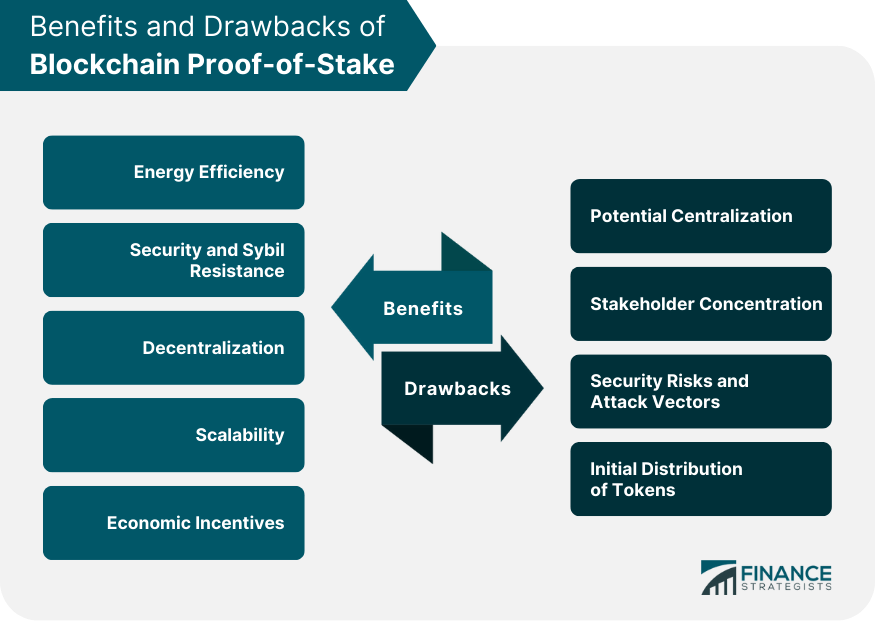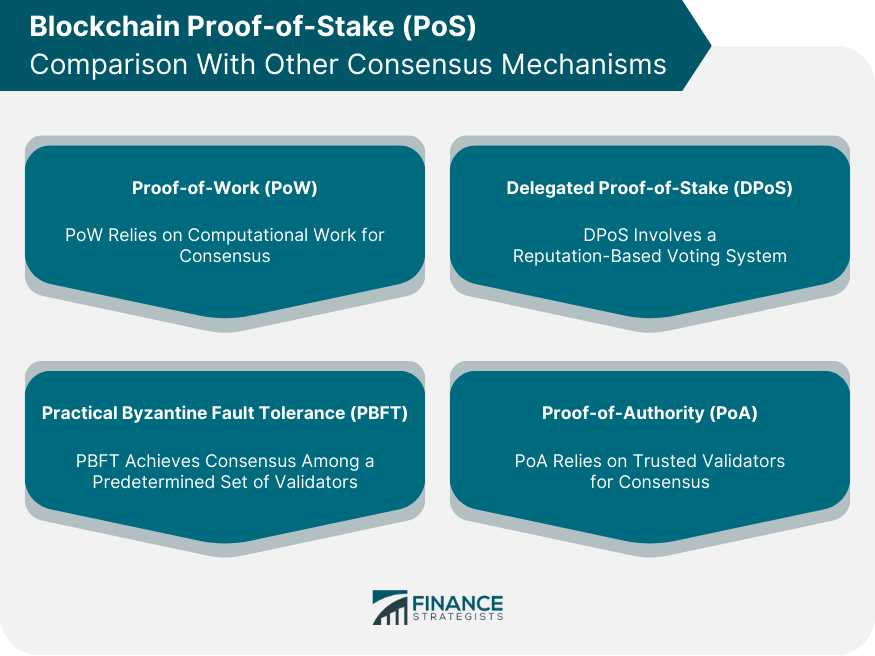Blockchain Proof-of-Stake (PoS) is a consensus mechanism used in blockchain networks to reach an agreement on the state of the ledger. Unlike traditional Proof-of-Work (PoW), where miners solve complex puzzles, PoS relies on staking. Staking means holding and locking up a certain amount of tokens to participate in the consensus process. The primary purpose of PoS is to provide a secure and efficient way to achieve consensus in a decentralized manner. It aims to address the drawbacks of PoW, such as high energy consumption and scalability issues. PoS encourages token holders to actively contribute to network security and maintain its integrity. In PoS, consensus is reached by selecting validators based on the number of tokens they hold and are willing to stake. Validators with a larger stake have a higher chance of being chosen. This mechanism ensures that those with a greater economic interest in the network have a stronger influence over decision-making. Validators play a crucial role in PoS by proposing and validating new blocks. To become a validator, one needs to lock up a certain amount of tokens as collateral. This stake acts as a guarantee of honest behavior. Validators are motivated to follow the rules and validate transactions correctly to avoid penalties or losing their stake. Validators take turns creating blocks and adding them to the blockchain. The probability of being chosen to create a block is proportional to the size of their stake. Once a block is proposed, other validators verify its validity. Consensus is reached when a majority of validators agree on the inclusion of the block in the blockchain. This process ensures the integrity and immutability of the ledger. One significant advantage of PoS over PoW is its lower energy consumption. PoS requires far less computational power, resulting in reduced environmental impact and cost savings. PoS provides robust security against attacks. To launch a successful attack, an attacker would need to acquire a majority of the tokens, which is economically impractical. PoS also includes penalties for malicious behavior, further discouraging attacks and ensuring network security. PoS promotes decentralization by allowing a wide range of participants to become validators. This inclusiveness encourages broader network participation and reduces the risk of concentration of power in the hands of a few entities. Scalability is a critical challenge for many blockchain networks. PoS addresses this by allowing faster block creation and confirmation times, resulting in higher transaction throughput and improved scalability. PoS introduces economic incentives for token holders. By staking their tokens, holders can earn additional tokens as rewards. This motivates long-term investment in the network and active participation in its governance, strengthening its overall stability. While PoS aims for decentralization, it can still be prone to centralization if a small number of entities amass a significant share of the tokens. This concentration of power raises concerns about governance and potential manipulation of the network. The initial distribution of tokens in a PoS network can impact its level of decentralization. Unequal token distribution may lead to a few stakeholders having a disproportionate influence on decision-making, potentially undermining the democratic nature of the network. While PoS provides robust security, it is not immune to certain attacks. Potential vulnerabilities include the "nothing-at-stake" problem and "long-range attacks." However, these risks can be mitigated through various techniques and network parameters. The fairness and inclusivity of the initial token distribution are crucial for the legitimacy and acceptance of a PoS network. Transparent and equitable distribution mechanisms help foster trust, ensuring a diverse stakeholder base and a more robust network. PoS differs from PoW in its approach to achieving consensus. PoW relies on computational work, while PoS leverages token ownership. Each has its strengths and weaknesses, with PoW excelling in security at the expense of energy consumption and PoS offering energy efficiency and scalability advantages. DPoS is a variation of PoS that introduces a reputation-based voting system. Token holders elect a limited number of delegates to validate transactions and create blocks. DPoS aims to enhance scalability by reducing the number of validators while maintaining a degree of decentralization. PBFT is a consensus mechanism used in permissioned blockchain networks. It focuses on consensus among a predetermined set of validators. PBFT achieves fast block confirmation times but sacrifices decentralization for performance and efficiency. PoA is another consensus mechanism used in permissioned blockchain networks. It relies on trusted validators who are predefined and known to the network participants. PoA provides fast block confirmation times but sacrifices decentralization for greater governance control. Ethereum, a prominent blockchain platform, is transitioning from PoW to PoS with its Ethereum 2.0 upgrade. The shift aims to improve scalability and energy efficiency while maintaining decentralization and security. Cardano is a blockchain platform that utilizes a unique PoS mechanism called Ouroboros. Ouroboros relies on rigorous mathematical principles to achieve consensus. Cardano aims to provide scalability, sustainability, and security for decentralized applications. Polkadot is a multi-chain platform that employs a hybrid PoS mechanism called Nominated Proof-of-Stake (NPoS). NPoS combines PoS and DPoS to provide scalability, interoperability, and shared security across multiple connected blockchains. Tezos is a self-amending blockchain platform that utilizes a variant of PoS called Liquid Proof-of-Stake (LPoS). LPoS incorporates a formal governance mechanism, allowing token holders to propose and vote on protocol upgrades, making Tezos a self-evolving blockchain. Developers are exploring hybrid consensus mechanisms that combine the strengths of PoS and other approaches. These hybrids aim to strike a balance between security, scalability, and decentralization, providing more efficient and robust consensus models. Improving governance mechanisms within PoS networks can enhance decision-making processes and prevent stakeholder concentration. Introducing mechanisms for fair voting, on-chain governance, and dispute resolution can contribute to more inclusive and transparent network management. Efforts to enable interoperability between different blockchain networks are crucial. Developing standards and protocols that facilitate seamless communication and asset transfer across chains will unlock new possibilities for decentralized applications and enhance the overall blockchain ecosystem. Blockchain Proof-of-Stake (PoS) serves as an innovative consensus mechanism that mitigates the energy consumption and scalability issues tied to Proof-of-Work systems. By relying on staking, or token holdings, to influence decision-making and maintain network integrity, PoS effectively balances security, energy efficiency, and democratization of power. Although potential drawbacks, like possible centralization and security risks, must be considered, these can be mitigated through strategies like fair token distribution and robust network parameters. PoS presents a unique blend of advantages that have proven instrumental in the evolution of prominent blockchain platforms such as Ethereum 2.0, Cardano, and Polkadot. To leverage these advancements for your financial growth, consider consulting a wealth management service capable of guiding your investment strategies in this rapidly evolving landscape. What Is Blockchain Proof-of-Stake (PoS)?
How Does Blockchain Proof-of-Stake Work?
Consensus Mechanism
Validators and Staking
Block Creation and Validation
Benefits of Blockchain Proof-of-Stake
Energy Efficiency
Security and Sybil Resistance
Decentralization
Scalability
Economic Incentives
Drawbacks of Blockchain Proof-of-Stake
Potential Centralization
Stakeholder Concentration
Security Risks and Attack Vectors
Initial Distribution of Tokens

Comparison With Other Consensus Mechanisms
Proof-of-Work (PoW)
Delegated Proof-of-Stake (DPoS)
Practical Byzantine Fault Tolerance (PBFT)
Proof-of-Authority (PoA)

Case Studies and Applications
Ethereum 2.0
Cardano
Polkadot
Tezos
Future Outlook and Potential Improvements
Hybrid Approaches
Enhanced Governance Mechanisms
Interoperability and Cross-Chain Compatibility
Final Thoughts
Blockchain Proof-of-Stake FAQs
PoS is a consensus mechanism where validators secure the network by staking tokens, enabling energy efficiency and scalability.
PoS offers energy efficiency, robust security, decentralization, scalability, and economic incentives for token holders.
Potential drawbacks include centralization risks, stakeholder concentration, security vulnerabilities, and initial token distribution concerns.
PoS differs from PoW, DPoS, PBFT, and PoA in its approach to consensus, energy consumption, validator selection, and decentralization.
Ethereum 2.0, Cardano, Polkadot, and Tezos are notable projects implementing PoS to improve scalability, sustainability, and security.
True Tamplin is a published author, public speaker, CEO of UpDigital, and founder of Finance Strategists.
True is a Certified Educator in Personal Finance (CEPF®), author of The Handy Financial Ratios Guide, a member of the Society for Advancing Business Editing and Writing, contributes to his financial education site, Finance Strategists, and has spoken to various financial communities such as the CFA Institute, as well as university students like his Alma mater, Biola University, where he received a bachelor of science in business and data analytics.
To learn more about True, visit his personal website or view his author profiles on Amazon, Nasdaq and Forbes.















